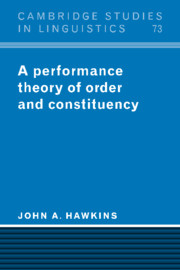Book contents
- Frontmatter
- Contents
- Preface
- Acknowledgments
- List of abbreviations
- 1 Introduction
- 2 The grammaticalization of processing principles
- 3 Early immediate constituents
- 4 Testing EIC's performance predictions
- 5 Testing EIC's grammatical predictions
- 6 Grammaticalized node construction
- 7 Conclusions
- Envoi
- Notes
- References
- Index of names
- Index of languages
- Subject index
1 - Introduction
Published online by Cambridge University Press: 18 September 2009
- Frontmatter
- Contents
- Preface
- Acknowledgments
- List of abbreviations
- 1 Introduction
- 2 The grammaticalization of processing principles
- 3 Early immediate constituents
- 4 Testing EIC's performance predictions
- 5 Testing EIC's grammatical predictions
- 6 Grammaticalized node construction
- 7 Conclusions
- Envoi
- Notes
- References
- Index of names
- Index of languages
- Subject index
Summary
A processing approach to syntax
Since the publication of Chomsky (1957) we have seen the development of a rich tradition of generative research into syntax. This tradition began by incorporating structuralist insights (cf. Saussure 1916; Bloomfield 1933; Harris 1951) into the kinds of grammatical rules that were widely employed in traditional grammars such as Jespersen (1924), thereby making these latter more explicit and more predictive in relation to grammaticality data (cf. Chomsky 1956). It led to a hypothesis about the role of grammatical knowledge within a larger theory of performance (cf. Chomsky 1965). It has contributed fundamental new insights into basic properties of natural language syntax and also into semantics, e.g. “constituent-command” (c-command) (cf. Reinhart 1983). It has elevated the goals of grammatical analysis beyond the facts of individual languages towards the construction of a theory of Universal Grammar (or UG), with built-in parameters of variation (cf. Chomsky 1981, 1982). And it has led to the formulation of numerous alternative models based on competing foundational concepts, whose empirical consequences are currently being worked out (cf. e.g. Aoun 1985, 1986; Gazdar, et al. 1985; Chomsky 1986; Blake 1990; and the papers in Baltin and Kroch 1989).
The philosophy that has been proposed as an explanatory background to, and motivation for, these generative descriptions is the innateness hypothesis (cf. e.g. Chomsky 1968).
- Type
- Chapter
- Information
- A Performance Theory of Order and Constituency , pp. 1 - 18Publisher: Cambridge University PressPrint publication year: 1995
- 1
- Cited by



